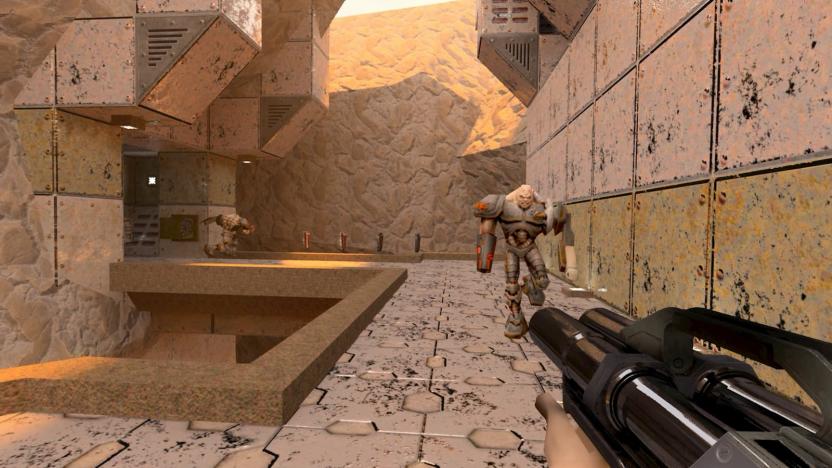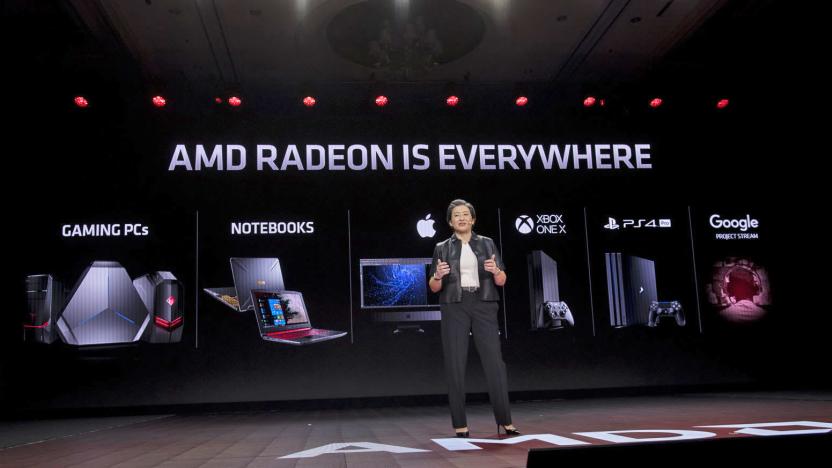ray-tracing
Latest

The free 'Quake II RTX' demo is now available on Steam
To show off the capabilities of path tracing, NVIDIA has released an updated version of id Software's classic 1997 FPS Quake II. You can play the first three single-player levels of Quake II RTX for free, and if you own the full game, you'll be able to play the whole thing in path tracing mode, including multiplayer.

AMD isn't ruling out ray tracing for its new Radeon RX 5000 GPUs
AMD finally unveiled its first Navi-based "RDNA" video cards this morning, the Radeon RX 5000-series. But, curiously, it's still keeping plenty of details under wraps. In particular, the company hasn't said anything definitive on real-time ray tracing, the technology that NVIDIA banked on with its RTX GPUs. It allows for more realistic lighting, reflections and shadows -- you can think of it as the next major visual upgrade after HDR.

NVIDIA is giving away the 'Quake II' ray tracing demo on June 6th
Earlier this year, a team inside NVIDIA took Quake II and ran it through its ray tracing system to see if the 1997 title could be gussied up. The resulting tech demo, shown off at GDC, received more than half a million YouTube views and more than a little hype. From June 6th, the company will allow people to play a limited version of the game — Quake II RTX — for free.

AMD partner leaks two mid-range Navi GPUs
AMD is set to announce more GPUs based on its 7-nanometer Navi tech, according to a leak from Sapphire, one of its largest graphics card partners. At Computex, CEO Lisa Su will reportedly unveil the Navi XT that can best the NVIDIA RTX 2070 for $499. AMD will also launch the Navi Pro, with performance between the RTX 2060 and RTX 2070 for $399. The Radeon VII, meanwhile, will remain AMD's flagship GPU.

NVIDIA’s RTX ray tracing put to the test
Welcome to the first episode of our new explainer series, Upscaled. We're going to be examining the components and gadgets that are helping move technology forward, and in this first episode, we're looking at graphics cards.

NVIDIA unleashes GeForce GTX 480 and GTX 470 'tessellation monsters'
Let's get the hard data out of the way first: 480 CUDA cores, 700 MHz graphics and 1,401MHz processor clock speeds, plus 1.5GB of onboard GDDR5 memory running at 1,848MHz (for a 3.7GHz effective data rate). Those are the specs upon which Fermi is built, and those are the numbers that will seek to justify a $499 price tag and a spectacular 250W TDP. We attended a presentation by NVIDIA this afternoon, where the above GTX 480 and its lite version, the GTX 470, were detailed. The latter card will come with a humbler 1.2GB of memory plus 607MHz, 1,215MHz and 1,674MHz clocks, while dinging your wallet for $349 and straining your case's cooling with 215W of hotness. NVIDIA's first DirectX 11 parts are betting big on tessellation becoming the way games are rendered in the future, with the entire architecture being geared toward taking duties off the CPU and freeing up its cycles to deliver performance improvements elsewhere. This is perhaps no better evidenced than by the fact that both GTX models scored fewer 3DMarks than the Radeon HD 5870 and HD 5850 that they're competing against, but managed to deliver higher frame rates than their respective competitors in in-game benchmarks from NVIDIA. The final bit of major news here relates to SLI scaling, which is frankly remarkable. NVIDIA claims a consistent 90 percent performance improvement (over a single card) when running GTX 480s in tandem, which is as efficient as any multi-GPU setup we've yet seen. After the break you'll find a pair of tech demos and a roundup of the most cogent reviews.%Gallery-89115%

NVIDIA Fermi / GF100 architectural details revealed
Fermi hardware might still be two months away, but NVIDIA has done the sage thing and released some tantalizing numbers and architectural details to keep the fanboys chirping in the meantime. The GF100 will signal the end of tiresome rebadging and clock speed massaging, and early adopters will find 512 CUDA cores, 48 ROPs, and a 384-bit GDDR5 memory interface sprawled across three billion transistors. Big changes are also afoot in how the card will do its work, with a reorganization toward a more parallel workflow leading to promises of up to eight times better geometry performance than on the GT200. HardOCP reports that anti-aliasing results have improved "notably," while the video we've got stashed after the break for you shows the GF100 beating the GTX 285 handily in a Far Cry 2 benchmark. Still, the PC Perspective crew expressed some apprehension about the massive die size and how it could impact yields given the still young 40nm production process -- a sentiment echoed by other publications who questioned whether NVIDIA would not have been better off trying for a less ambitious, more gaming-oriented board. We should all know that answer soon enough. Read - AnandTech Read - Hot Hardware Read - PC Perspective Read - HardOCP Read - Tom's Hardware

Get ready for another co-processor: further details on Caustic Graphics's RTPU
Ray tracing is the current holy grail of gaming graphics, the rendering technique that might finally make the licensed game based on Pixar's latest look as good as the film itself. But, the typically random nature of rays has made rendering them on traditional hardware inefficient, a problem Caustic Graphics claimed to have solved, and is now backing that up by giving PC Perspective some further details and demos. The company's tech will rely on a new graphics co-processor called the Ray Tracing Processing Unit (RTPU), working in concert with existing 3-D accelerators to deliver rays at frame rates high enough for interactive applications. How high? Early hardware dubbed CausticOne (that giant slab of silicon above) manages 3 - 5 frames-per-second in the demonstration video after the break. That's not nearly enough for twitchy first-person shooters, but second-gen hardware due next year is looking to deliver 14 times that -- plenty to get your high-reflectivity frag on.

Intel: Some example of Ray Traced gaming likely in 2-3 years
Already looking to the future, Intel's Dr. Michael Vollmer expressed hope towards the future of ray traced visuals in gaming. When asked by PC Gaming Hardware if there were developers already working on ray traced games, Vollmer said, "I dare say that in two to three years time we will see something," noting that he keeps in touch with companies all over the world.Ray tracing is a graphics technique that is capable of some impressive, photorealistic visuals but conversely is very computational-intensive. Vollmer also said that the raytracing demo shown last month should be seen as a technical demo and that the graphics portion had been taken from the non-raytraced optimized Enemy Territory: Quake Wars. Speaking of which, we couldn't think of a more likely candidate for showcasing raytraced graphics than John Carmack and Id Software, except maybe Crytek. If Vollmer's estimates are accurate, we hope to see some ray traced frag fest in time for the 2011 Game Developers Conference.[Via Blue's News]

NVIDIA gobbles up ray tracing software maker RayScale
Details are pretty slim on this one at the moment, but PC Perspective is reporting that NVIDIA has snapped up the Utah-based start-up RayScale, a maker of ray tracing software. As PC Perspective points out, the move is made particularly interesting in light of some recent comments made by NVIDIA CTO David Kirk, who mused about the merging of ray tracing and rasterization into a "hybrid renderer" of sorts, but didn't offer any firm details on the company's plans at the time. No word on a price tag for the acquisition just yet, or any other details for that matter, but it seems like things should be getting a bit more official in the next few days.

Real-time ray-tracing on the PlayStation 3! [update 1]
This is one of those moments where the hardware does the talking and not the software. The video above contains some real-time ray-tracing, where three PS3's "render a model that is 75x more complex then those used in today's games. Ray-tracing is the rendering technique used by the film industry and is considered to complex for today's game systems."What's more impressive about the video is that the RSX graphics chip wasn't even touched -- the cell processor is creating all of what you see, even calculating where shadows should land given a certain style of lighting. If one Cell SPE (hmm... see the update) can create what you see there, with calculated light and shadows run in real-time, imagine what eight of them could do in addition to the RSX graphics chip. We really need someone to start making the PS3 game now so it can be done in eight years or so.[Update: Apparently Linux limits the use of SPE's to a total of 6, so the three PS3's "duct-taped together" are utilizing 6 SPE's, not one as incorrectly gleaned initially!][Thanks Truespeed and Colin!]





